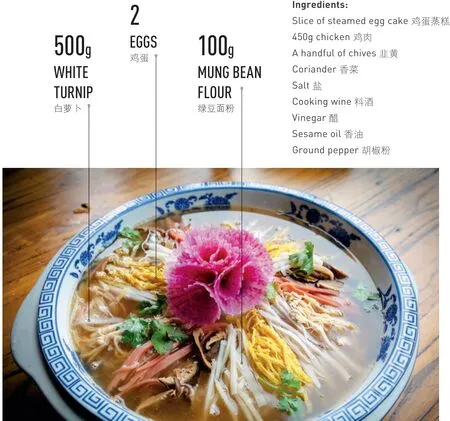BLOOMING BANQUET
2020-10-23BYAARONHSUEH薛凌桥
BY AARON HSUEH (薛凌桥)
A floral feast that fuses the fine tastes of China’s ancient capital, Luoyang
牡丹燕菜:在洛阳,萝卜也能吃出花来
“Receiving friends with my cheap wine/ With turnip soup in hand, its taste rivals the venison (茅柴酒与人情好,萝卜羹和野味长),”the literatus Chen Zhu (陈著) thus praised, of all things, the pungent turnip in the 13th century.Cheap but nutrient-rich, the turnip was an all-purpose vegetable enjoyed by commoners and nobles alike.In traditional Chinese medicine, it is thought to balance theqiin the stomach and aid digestion.
Even the commonest root vegetable,though, can be made to look and taste good with help from a skilled chef:mudan yancai(牡丹燕菜), or “peony and swallow dish,” is a nourishing soup made of steamed turnip arranged around a blooming peony flower made of egg or tofu skin. As the opening dish to the Luoyang Water Banquet, a famous spread of 24 mainly soup-based dishes from one of the ancient capitals of the Tang dynasty (618 – 907),mudan yancaiis considered a perfect fusion of color,aroma, and taste.
Mudan yancaiwas originally known asyicai(义菜), the “righteous dish,” as the female emperor Wu Zetian, before she came into power, allegedly lived on turnips during a brief demotion at court and almost starved to death.After she ascended the throne, a Luoyang farmer gifted the emperor with a large turnip weighing some 60 taels. Royal chefs creatively matched it with delicacies like swallow’s nest and pine mushrooms, and the dish caught on across restaurants in the capital as both common folks and nobles vied to follow the royal trend.

It’s not clear how the dish came to be connected with the peony, but its flower-like appearance is certainly its best selling point. The peony is also the official flower of Luoyang. As the Tang poet Liu Yuxi (刘禹锡) once commented, “Of all flowers, in my mind, only the peony can represent the beauty of the nation. The whole capital is amazed when it blossoms.”The dish is seasoned to taste both sour and spicy, and the turnip feels refreshing and smooth on the tongue.
In October 1974, when Premier Zhou Enlai received Canadian prime minister Pierre Trudeau in Luoyang, he praised the beauty of the peony shape at the center of themudan yancai, and officially named the dish “Luoyangyancai.” Though the ingredients can vary from high-end to basic, authentic recipes call for a white turnip, mung bean flour, and eggs. Today, tourists can visit the Zhenbutong Restaurant in Luoyang,a time-honored brand founded in 1895, and lose themselves in the culture of the ancient city amid the delicate turnip dish and antique-style adornments.

Steps:
1. Boil the chicken in water for 10 minutes, then ladle out. Set soup aside.
2. Beat the eggs and fry into a thin pancake
3. Chop the chicken, fried egg, and chives into thin slices
4. Cut the turnip into half-inch slices. Soak for 25 minutes in cold water, and drain
5. Coat the turnip slices in mung bean flour and steam for 5 minutes. After they cool,soak the slices again in warm water and then ladle out and set aside.
6. Arrange the slices of turnip, chicken, egg, and chives in sections radiating from the center of the dish to the rim, leaving some room in the center
7. Add all seasoning except coriander into the chicken soup to taste, and boil
8. Pour soup over the ingredients in the dish, then garnish with coriander. Cut the steamed egg cake into petal shapes and arrange in the center of the dish.

